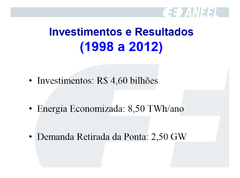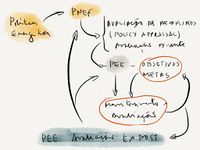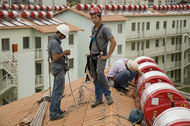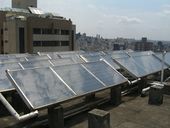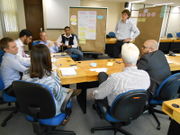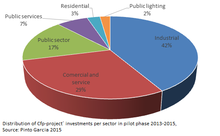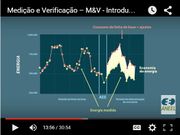Knowledge fuels change
For over a decade, Energypedia has shared free, reliable energy expertise with the world.
We’re now facing a serious funding gap.
Help keep this platform alive — your donation, big or small, truly matters!
Thank you for your support
Difference between revisions of "Energy Efficiency Program (PEE) in Brazil"
***** (***** | *****) |
***** (***** | *****) |
||
| (36 intermediate revisions by 4 users not shown) | |||
| Line 1: | Line 1: | ||
| + | |||
= <references />Overview<br/> = | = <references />Overview<br/> = | ||
| − | This article informs about the Brazilian Energy Efficiency Program ''(port. Programa de Eficiência Energética - ''PEE) and the recent improvement of PEE´s regulatory framework. The Brazilian electricity regulation authority ANEEL (''port. Agência Nacional de Energia Elétrica'' - ANEEL''), ''competent supervising entity of the PEE, was supported by Deutsche Gesellschaft für Internationale Zusammenarbeit (GIZ) GmbH | + | This article informs about the Brazilian Energy Efficiency Program ''(port. Programa de Eficiência Energética - ''PEE) and the recent improvement of PEE´s regulatory framework. The Brazilian electricity regulation authority ANEEL (''port. Agência Nacional de Energia Elétrica'' - ANEEL''), ''competent supervising entity of the PEE, was supported by Deutsche Gesellschaft für Internationale Zusammenarbeit (GIZ) GmbH on behalf of the German Federal Ministry for Economic Cooperation and Development (BMZ). The new regulation entered into force on 2<sup>nd</sup> July 2013. |
| + | |||
= Introduction<br/> = | = Introduction<br/> = | ||
| Line 8: | Line 10: | ||
Energy efficiency policies still play a marginal role in Brazil. Vast energy saving potentials exists in many sectors, especially in the industry and commerce. Along with the residential sector, these are the most energy intensive sectors in Brazil. Since the beginning of the century, however, the country is gradually building a regulatory framework to develop such policies. | Energy efficiency policies still play a marginal role in Brazil. Vast energy saving potentials exists in many sectors, especially in the industry and commerce. Along with the residential sector, these are the most energy intensive sectors in Brazil. Since the beginning of the century, however, the country is gradually building a regulatory framework to develop such policies. | ||
| − | In 2000, the Brazilian government legally implemented the PEE under regulation and supervision of the ANEEL. PEE demands the 100 electricity providers in the regulated energy market to spend 0.5 percent of their yearly net operating income in energy efficiency projects, which represents a total budget of approx. 120 Mio. Euro per year. This makes PEE the largest financial source for energy efficiency projects in Brazil. Between 2008 and 2012, most projects were implemented in the low <ref name="PROPEE">ANEEL 2013: Procedimentos do Programa de Eficiência Energética – PROPEE. Módulo 1 – Introdução. www.aneel.gov.br/arquivos/zip/PROPEEv1.zip (Retrieved on 1-8-2015)</ref>income household sector (62%). However, analysis conducted by ANEEL showed trends of declining returns of PEE resources, and that adjustments in the regulation were necessary. [[File:Investimentos e Resultados PEE 1998 a 2012.png|border|right|240px|Investimentos e Resultados PEE 1998 a 2012|alt=Investimentos e Resultados PEE 1998 a 2012]] | + | In 2000, the Brazilian government legally implemented the PEE under regulation and supervision of the ANEEL. PEE demands the 100 electricity providers in the regulated energy market to spend 0.5 percent of their yearly net operating income in energy efficiency projects, which represents a total budget of approx. 120 Mio. Euro per year. This makes PEE the largest financial source for energy efficiency projects in Brazil. Between 2008 and 2012, most projects were implemented in the low <ref name="PROPEE">ANEEL 2013: Procedimentos do Programa de Eficiência Energética – PROPEE. Módulo 1 – Introdução. www.aneel.gov.br/arquivos/zip/PROPEEv1.zip (Retrieved on 1-8-2015)</ref> income household sector (62%). However, analysis conducted by ANEEL showed trends of declining returns of PEE resources, and that adjustments in the regulation were necessary. [[File:Investimentos e Resultados PEE 1998 a 2012.png|border|right|240px|Investimentos e Resultados PEE 1998 a 2012|alt=Investimentos e Resultados PEE 1998 a 2012]] |
More information about PEE can be found in the following power point presentation: | More information about PEE can be found in the following power point presentation: | ||
| Line 16: | Line 18: | ||
Numbers and Facts Energy Efficieny Program - [http://www.aneel.gov.br/aplicacoes/audiencia/arquivo/2012/073/documento/propee_rpo_18-09-2012.pdf Procedimentos do Programa de Eficiência Energética Regulado pela ANEEL - PROPEE (2012)] | Numbers and Facts Energy Efficieny Program - [http://www.aneel.gov.br/aplicacoes/audiencia/arquivo/2012/073/documento/propee_rpo_18-09-2012.pdf Procedimentos do Programa de Eficiência Energética Regulado pela ANEEL - PROPEE (2012)] | ||
| − | = Enhanced regulatory framework = | + | <br/>[[Energy Efficiency Program (PEE) in Brazil#toc|►Go to Top]] |
| + | |||
| + | <br/> | ||
| + | |||
| + | = Enhanced regulatory framework<br/> = | ||
[[File:Programa de Eficiência Energética (ANEEL) Logo.png|border|left|150px|Programa de Eficiência Energética (ANEEL) Logo|alt=Programa de Eficiência Energética (ANEEL) Logo]]New regulatory framework of PEE - [http://www.aneel.gov.br/area.cfm?idArea=27 Procedimentos do Programa de Eficiência Energética - PROPEE (2013)] | [[File:Programa de Eficiência Energética (ANEEL) Logo.png|border|left|150px|Programa de Eficiência Energética (ANEEL) Logo|alt=Programa de Eficiência Energética (ANEEL) Logo]]New regulatory framework of PEE - [http://www.aneel.gov.br/area.cfm?idArea=27 Procedimentos do Programa de Eficiência Energética - PROPEE (2013)] | ||
| Line 33: | Line 39: | ||
This study summarizes the most important changes done at the PEE´s regulatory framework, such as the introduction of “Call for projects”, the possibility of co-financing PEE projects with private funds, incentives to performance contracts, inclusion of incentivized energy sources (which also promotes → [[Net Metering in Brazil|Net Metering in Brazil]]), standardization of M&V procedures, among others. | This study summarizes the most important changes done at the PEE´s regulatory framework, such as the introduction of “Call for projects”, the possibility of co-financing PEE projects with private funds, incentives to performance contracts, inclusion of incentivized energy sources (which also promotes → [[Net Metering in Brazil|Net Metering in Brazil]]), standardization of M&V procedures, among others. | ||
| + | |||
| + | <br/>[[Energy Efficiency Program (PEE) in Brazil#toc|►Go to Top]] | ||
<br/> | <br/> | ||
| Line 63: | Line 71: | ||
<br/> | <br/> | ||
| − | [[File:Evaluation of PEE and its role in energy planning.jpg|border|right| | + | [[File:Evaluation of PEE and its role in energy planning.jpg|border|right|200px|Evaluation of PEE and its role in energy planning|alt=Evaluation of PEE and its role in energy planning]] Proposals to improve the regulation for monitoring and evaluation of PEE - [[:File:Monitoramento e Avaliação do PEE Propostas para o Aprimorament.pdf|Monitoramento e Avaliação do PEE: Propostas para o Aprimoramento Regulatório do PEE (2012)]]<br/> |
Following PEE´s M&V directives from 2008 for assessing energy saving results of PEE projects, this study presents best practices from UK and United States in M&V the performance of energy efficiency programs. It evaluates the M&V methodology used for the PEE as well as presents an impact evaluation methodology proposal for PEE as an energy efficiency policy.<br/> | Following PEE´s M&V directives from 2008 for assessing energy saving results of PEE projects, this study presents best practices from UK and United States in M&V the performance of energy efficiency programs. It evaluates the M&V methodology used for the PEE as well as presents an impact evaluation methodology proposal for PEE as an energy efficiency policy.<br/> | ||
| − | |||
| − | |||
<br/> | <br/> | ||
| Line 73: | Line 79: | ||
Proposals for the regulatory improvement of energy efficiency projects in low income households - [[:File:Eficiência Energética em Comunidades de Baixa Renda Propostas.pdf|Eficiência Energética em Comunidades de Baixa Renda: Propostas para o Aprimoramento Regulatório do PEE (2012)]]<br/> | Proposals for the regulatory improvement of energy efficiency projects in low income households - [[:File:Eficiência Energética em Comunidades de Baixa Renda Propostas.pdf|Eficiência Energética em Comunidades de Baixa Renda: Propostas para o Aprimoramento Regulatório do PEE (2012)]]<br/> | ||
| − | [[File:Solar | + | [[File:Solar Collector for Water Heating on Social Housing Rooftop - Rio de Janeiro.jpg|border|left|190px|Installation of solar collectors on social housing rooftop - Rio de Janeiro|alt=Solar Collector for Water Heating on Social Housing Rooftop - Rio de Janeiro.jpg]] |
Law 12.212/2010<ref name="LEI Nº 12.212">Presidência da República 2010: LEI Nº 12.212, DE 20 DE JANEIRO DE 2010. http://www.planalto.gov.br/ccivil_03/_Ato2007-2010/2010/Lei/L12212.htm (Retrieved on 12-18-2014)</ref> demands at least 60% of PEE’s total investment to be applied in the low income residential sector (between 2008 and 2012, 70% of total spent has been applied there). However, concerns about the cost effectiveness of these projects due to declining cost-benefit ratios along time, the sustainability of donation measures as well as the durability of energy savings led to the inclusion of this issue in PEE´s improvement process. This study analyzes these problems thoroughly and identifies improvement potentials.<br/> | Law 12.212/2010<ref name="LEI Nº 12.212">Presidência da República 2010: LEI Nº 12.212, DE 20 DE JANEIRO DE 2010. http://www.planalto.gov.br/ccivil_03/_Ato2007-2010/2010/Lei/L12212.htm (Retrieved on 12-18-2014)</ref> demands at least 60% of PEE’s total investment to be applied in the low income residential sector (between 2008 and 2012, 70% of total spent has been applied there). However, concerns about the cost effectiveness of these projects due to declining cost-benefit ratios along time, the sustainability of donation measures as well as the durability of energy savings led to the inclusion of this issue in PEE´s improvement process. This study analyzes these problems thoroughly and identifies improvement potentials.<br/> | ||
| Line 87: | Line 93: | ||
Proposals to include projects with renewable energy sources into the PEE - [[:File:Desenvolvimento de Propostas para Inclusão Fontes Incentivadas de Energia Elétrica.pdf|Desenvolvimento de Propostas para Inclusão de Fontes Incentivadas de Energia Elétrica no PEE da ANEEL (2012)]] | Proposals to include projects with renewable energy sources into the PEE - [[:File:Desenvolvimento de Propostas para Inclusão Fontes Incentivadas de Energia Elétrica.pdf|Desenvolvimento de Propostas para Inclusão de Fontes Incentivadas de Energia Elétrica no PEE da ANEEL (2012)]] | ||
| − | [[File:PV | + | [[File:PV Installation on Urban Rooftop.JPG|border|right|170px|PV installation on urban rooftop|alt=PV installation on urban rooftop]] |
This study analyses, evaluates and proposes rules and procedures to authorize PEE funding for projects that combine small scale, distributed renewable power plants and at least one conventional energy efficiency measure to be considered for the new PEE regulation. Distributed, renewable electricity generation projects (so called “incentivized energy sources"<ref name="incentivized sources">Incentivized sources under the PEE regulation are electricity generation plants with an installed capacity of at least 100 kW (Micro-Generation) or at least 100 kW to 1 MW (Mini-Generation) which use hydro, solar, wind, biomass or cogeneration as energy source and is connected to the grid following the regulation of ANEEL. Read more: Procedimentos do Programa de Eficiência Energética – PROPEE. Módulo 6 – Projetos com Fontes Incentivadas. www.aneel.gov.br/arquivos/zip/PROPEEv1.zip (Retrieved on 12-23-2014)</ref>) are a cost-effective way to increase energy efficiency in the framework of PEE. These projects allow end consumers to not only achieve higher levels of energy efficiency, but also become small electricity generation plants, able to export electricity surpluses into the grid according to the Net Metering regulation (→ [[Net Metering in Brazil|Net Metering in Brazil]]).<br/> | This study analyses, evaluates and proposes rules and procedures to authorize PEE funding for projects that combine small scale, distributed renewable power plants and at least one conventional energy efficiency measure to be considered for the new PEE regulation. Distributed, renewable electricity generation projects (so called “incentivized energy sources"<ref name="incentivized sources">Incentivized sources under the PEE regulation are electricity generation plants with an installed capacity of at least 100 kW (Micro-Generation) or at least 100 kW to 1 MW (Mini-Generation) which use hydro, solar, wind, biomass or cogeneration as energy source and is connected to the grid following the regulation of ANEEL. Read more: Procedimentos do Programa de Eficiência Energética – PROPEE. Módulo 6 – Projetos com Fontes Incentivadas. www.aneel.gov.br/arquivos/zip/PROPEEv1.zip (Retrieved on 12-23-2014)</ref>) are a cost-effective way to increase energy efficiency in the framework of PEE. These projects allow end consumers to not only achieve higher levels of energy efficiency, but also become small electricity generation plants, able to export electricity surpluses into the grid according to the Net Metering regulation (→ [[Net Metering in Brazil|Net Metering in Brazil]]).<br/> | ||
| + | |||
| + | <br/>[[Energy Efficiency Program (PEE) in Brazil#toc|►Go to Top]] | ||
<br/> | <br/> | ||
= New PEE rules = | = New PEE rules = | ||
| + | |||
| + | As a result of the improvement process of the regulatory framework of PEE, several rules were modified and new ones were introduced. The following chapter gives an overview about the new PEE rules. Moreover, it contains studies that were carried out specifically to support the development of new and improved mechanisms of PEE. | ||
| + | |||
| + | <br/> | ||
| + | |||
| + | |||
== Projects selection - "Call for projects" == | == Projects selection - "Call for projects" == | ||
| − | == Measurement and Verification Procedure == | + | In 2013, ANEEL introduced a call for projects mechanism into the regulatory framework of PEE in order to link the execution of PEE projects with the promotion of the Brazilian energy efficiency market. The calls for projects are directioned to the society and especially to ESCOs to develop energy efficiency projects. In this way consumers and the market players are the ones that propose new projects instead of being only the electricity providers the ones who plan and execute the projects by themselves. With the introduction of the call for project mechanism, ANEEL started a pilot phase of two years. After this period, improved criteria were finally adopted in July 2015. |
| + | |||
| + | <br/> | ||
| + | |||
| + | ProPEE Module 3: Selection and implementation of projects – [http://peeenel.com.br/banco_dados/download/propee-modulo-3-selecao-e-implantacao-de-projetos-versao-01 ProPEE Modulo 3: Seleção e Implementação de Projetos (2015)] | ||
| + | |||
| + | This module of the ProPEE describes the selection and implementation of PEE projects through the introduction a new mechanism: call for projects. It defines the process and criteria for the realization of call for projects executed by the electricity providers in order to receive project proposals from ESCOs, consumers, efficient equipment manufacturers etc. | ||
| + | |||
| + | <br/> | ||
| + | |||
| + | Selection criteria for the call for projects mechanism - [http://www.aneel.gov.br/arquivos/zip/CriteriosChamada_Rev1.zip Critérios de Seleção para Chamadas Públicas de Projeto (2015)] | ||
| + | |||
| + | The selection criteria were also improved after the two-year pilot phase. Several debates were realized and studies were elaborated, reflecting about experiences made by the electricity providers with the prevailing rules for project selection. The rules, enforced in 2015, imply criteria like proportional cost-effectiveness and higher score for projects including generation from renewable sources, as well as qualified M&V professionals. | ||
| + | |||
| + | <br/> | ||
| + | |||
| + | [[File:Participants of workshop for the improvement of the call for projects mechanism (Brasilia, 2015).jpg|border|left|180px|Participants of workshop for the improvement of the call for projects mechanism (Brasilia, 2015)|alt=Participants of workshop for the improvement of the call for projects mechanism (Brasilia, 2015)]]Results of the workshop for the improvement of the call for projects mechanism - [[:File:Resultados da oficina de elaboração de insumos para o aprimoramento do processo de Chamadas Públicas de Projetos.pdf|Resultados da oficina de elaboração de insumos para o aprimoramento do processo de Chamadas Públicas de Projetos (2015)]] | ||
| + | |||
| + | In order to improve the regulation of the call for project mechanism, the feedback of the electricity providers that carried out calls for projects during the pilot phase was crucial. The workshop held by ANEEL in April 2015 and supported by GIZ aimed on collecting their experiences and promote the regulatory improvement using a participatory approach. There were three specific items that structured the discussions at the workshop, which counted with participation of all involved electricity distributers: qualification criteria, dissemination and training as well as selection criteria. | ||
| + | |||
| + | | ||
| + | |||
| + | [[File:Investimentos por tipologia.png|border|right|220pxpx|Distribution of Cfp-projects´ investments per sector in pilot phase 2013 - 2015|alt=Distribution of Cfp-projects´ investments per sector in pilot phase 2013 - 2015]]Evaluation of the pilot phase for the call for project mechanism and proposals for the definitive regulamentation - [[:File:Avaliação do período de teste das CPPs e sugestão da regulamentação definitiva.pdf|Avaliação do período de teste das CPPs e sugestão da regulamentação definitiva (2015)]] | ||
| + | |||
| + | After the two-years pilot phase, 15 calls for project, executed by 13 electricity providers, were realized. This study shows the results of the test period of call for projects and presents the final selection criteria. It demonstrates that most investments of PEE projects realized through call for projects were realized in the industrial sector (42%, see graph). The total proposed investments exceeded R$ 115 million, reducing the demand in about 90 GWh / year. | ||
| + | |||
| + | <br/> | ||
| + | |||
| + | |||
| + | |||
| + | |||
| + | == Measurement and Verification Procedure<br/> == | ||
| + | |||
| + | The rule to execute M&V of the PEE projects based on the directives of the International Performance Measurement and Verification Protocol (IPMVP) had already been introduced in 2008. However, electricity providers didn’t accomplish M&V of PEE projects until then because of missing specifications of M&V procedures. As a result, ANEEL had only poor data about PEE projects until 2013. Within the cooperation between GIZ and ANEEL, ANEEL specified the application of Measurement and Verification (M&V) within the new regulation of PEE: [[:File:InfoSheet Folha informativa Energy English MeV 28Abr2016.pdf|Measurement & Verification on the Brazilian Energy Efficiency Program]]<br/> | ||
| + | |||
| + | [[File:Timeline 1998 2014.png|border|center|500px|MeV timeline at the Brazilian Energy Efficiency Program (PEE)|alt=MeV timeline at the Brazilian Energy Efficiency Program (PEE)]]<br/> | ||
| + | |||
| + | ProPEE Module 8: Measurement and Verification of Results - [http://peeenel.com.br/banco_dados/download/propee-modulo-8-medicao-e-verificacao-de-resultados-versao-01 ProPEE Modulo 8: Medição e Verificação de Resultados (2013)]<br/> | ||
| + | |||
| + | The PEE-module M&V establishes prerequisites and determinations for measurement and verification of PEE. By its introduction, various important innovations to measure PEE´s results could be achieved. “Interactive effects” of energy efficiency projects such as savings in air conditioning systems resulting from improved lighting can now be considered in projects. Further to this, energy providers are held responsible for their calculations made for electrical systems: the new M&V-module adopted a “confidence level” of 95% compatibility for uncertainty calculations. | ||
| + | |||
| + | <br/> | ||
| + | |||
| + | M&V Guide -[http://www.aneel.gov.br/area.cfm?idArea=847&idPerfil=6&idiomaAtual=0 Guia de M&V (2014)]<br/> | ||
| + | |||
| + | The M&V guide was elaborated to describe in detail, standardize and facilitate the application of M&V methodologies by end use<ref name="M&V">Lighting in low-income residences, Refrigeration in low-income residences, Heating water in low-income residences (with or without solar collector), Lighting, Engines systems, Solar water heating, Environmental conditioning, Compressed air.</ref>. The M&V procedures covered in this guide are for the energy efficiency measures which are most implemented on electricity providers’ projects such as replacing lighting bulbs for more efficient ones. The guide also offers spreadsheets and documents to structure and document M&V of projects uniformly. <br/> | ||
| + | |||
| + | <br/> | ||
| + | |||
| + | Structure and Content of the PEE M&V Guide - [[:File:Estrutura e conteúdo do Guia de M&V.pdf|Estrutura e conteúdo do Guia de M&V para o PEE (2012)]] | ||
| + | |||
| + | Structure and content of the M&V guide was prepared thoroughly. This study pointed out detailed suggestions for every step of the M&V process to be defined in the M&V guide and for the standardized material. It gives instructions on how to prepare the M&V plan, the chronology of M&V measures to be taken, the electronic spreadsheets and the final report of the M&V process. | ||
| + | |||
| + | <br/> | ||
| + | |||
| + | [[File:Electricity providers participants of pilot trainings for M&V (May 2014, Brasilia).jpg|border|right|230px|Electricity providers participants of pilot trainings for M&V (May 2014, Brasilia)|alt=Electricity providers participants of pilot trainings for M&V (May 2014, Brasilia)]]Preparation of the M&V training for electricity providers -[[:File:Treinamentos sobre o Guia de M&V – Preparação dos treinamentos das Distribuidoras.pdf|Treinamentos de M&V - Preparação dos treinamentos das distribuidoras (2013)]] | ||
| + | |||
| + | In order to prepare the energy providers to execute PEE projects in accordance with the new M&V procedures, ANEEL organized three pilot trainings for representatives of the electricity providers. This report describes the capacity building measures and, subsequently, points out improvement suggestions and feedback obtained at M&V pilot trainings. Thereby, lessons learned led to a final revision of the guide and the M&V training methodology. The training, including introduction to the guide, was then carried out with 102 energy providers that execute projects within the framework of PEE. | ||
| + | |||
| + | <br/> | ||
| + | |||
| + | M&V training for electricity providers - [[:File:Avaliação dos treinamentos presenciais de M&V e ações iniciais de EAD.pdf|Avaliação dos treinamentos presenciais de M&V e ações iniciais de EAD (2014)]] | ||
| + | |||
| + | After the official publication of the M&V Guide, three trainings were held by ANEEL and GIZ to capacitate the company’s staff on its application. The trainings reached a wide number of electricity provider’s employees and the results were evaluated very positively by the participants. To make the knowledge transfer sustainable, e-learning materials and techniques were elaborated, like the video about basic concepts of M&V. | ||
| + | |||
| + | <br/> | ||
| + | |||
| + | [[File:Screenshot Video Basic concepts of M&V.jpg|border|left|180px|Screenshot Video Basic concepts of M&V|alt=Screenshot Video Basic concepts of M&V]]Video about basic concepts of M&V - Vídeo – [http://www.aneel.gov.br/area.cfm?idArea=847&idPerfil=6&idiomaAtual=0 Conceitos Básicos de M&V (2015)] | ||
| + | |||
| + | The understanding of the key knowledge for M&V and the sequence of how to execute M&V in PEE projects is crucial for the success of a standardized M&V process. Therefore, ANEEL and GIZ produced a video that explains the basic concepts of M&V and , by discussing exemplary cases of how to applicate these concepts on real energy efficiency projects, illustrates how to apply the main variables in order to assure a correct M&V of the projects. Then it shows step-by-step the M&V process proclaimed by ANEEL, which applies the methodologies ofInternational Performance Measurement and Verification Protocol IPMVP (International Performance Measurement and Verification Protocol). | ||
| + | |||
| + | <br/> | ||
| + | |||
| + | [[Energy Efficiency Program (PEE) in Brazil#toc|►Go to Top]] | ||
| + | |||
| + | <br/> | ||
| + | |||
| + | |||
| + | = Demonstrative projects = | ||
| + | |||
| + | = Publications = | ||
| + | |||
| + | [[:File:Measuring and verifying energy savings benefits EE projects.pdf|Measuring and verifying energy savings benefits EE projects (2015)]] | ||
| + | |||
| + | The following article was published in the 42<sup>th </sup>edition of the GIZ Newsletter due to the publication of the elaborated e-Learning training material for M&V: | ||
| + | |||
| + | [http://www.giz.de/expertise/html/2556.html GIZ Energy Newsletter index] | ||
| + | |||
| + | = Events = | ||
= Further Information = | = Further Information = | ||
| Line 103: | Line 205: | ||
*[http://www.evo-world.org/index.php?lang=en Efficiency Valuation Organization] (International Performance Measurement and Verification Protocol - IPMVP) | *[http://www.evo-world.org/index.php?lang=en Efficiency Valuation Organization] (International Performance Measurement and Verification Protocol - IPMVP) | ||
*[http://www.aneel.gov.br/area.cfm?idArea=27 ANEEL - Energy Efficiency] | *[http://www.aneel.gov.br/area.cfm?idArea=27 ANEEL - Energy Efficiency] | ||
| + | *[http://www.canalenergia.com.br/arquivos/image_bank/especiais/Grafico_PEE_Aneel_20155221216.jpghttp://www.canalenergia.com.br/arquivos/image_bank/especiais/Grafico_PEE_Aneel_20155221216.jpg Canal Energia - PEE investments and results] | ||
| + | |||
| + | <br/>[[Energy Efficiency Program (PEE) in Brazil#toc|►Go to Top]] | ||
| + | |||
| + | <br/> | ||
= References<br/> = | = References<br/> = | ||
<references /> | <references /> | ||
| + | |||
| + | <br/>[[Energy Efficiency Program (PEE) in Brazil#toc|►Go to Top]] | ||
[[Category:Renewable_Energy]] | [[Category:Renewable_Energy]] | ||
Latest revision as of 11:07, 16 August 2017
Overview
This article informs about the Brazilian Energy Efficiency Program (port. Programa de Eficiência Energética - PEE) and the recent improvement of PEE´s regulatory framework. The Brazilian electricity regulation authority ANEEL (port. Agência Nacional de Energia Elétrica - ANEEL), competent supervising entity of the PEE, was supported by Deutsche Gesellschaft für Internationale Zusammenarbeit (GIZ) GmbH on behalf of the German Federal Ministry for Economic Cooperation and Development (BMZ). The new regulation entered into force on 2nd July 2013.
Introduction
Energy efficiency policies still play a marginal role in Brazil. Vast energy saving potentials exists in many sectors, especially in the industry and commerce. Along with the residential sector, these are the most energy intensive sectors in Brazil. Since the beginning of the century, however, the country is gradually building a regulatory framework to develop such policies.
In 2000, the Brazilian government legally implemented the PEE under regulation and supervision of the ANEEL. PEE demands the 100 electricity providers in the regulated energy market to spend 0.5 percent of their yearly net operating income in energy efficiency projects, which represents a total budget of approx. 120 Mio. Euro per year. This makes PEE the largest financial source for energy efficiency projects in Brazil. Between 2008 and 2012, most projects were implemented in the low [1] income household sector (62%). However, analysis conducted by ANEEL showed trends of declining returns of PEE resources, and that adjustments in the regulation were necessary.
More information about PEE can be found in the following power point presentation:
Numbers and Facts Energy Efficieny Program - Procedimentos do Programa de Eficiência Energética Regulado pela ANEEL - PROPEE (2012)
Enhanced regulatory framework
New regulatory framework of PEE - Procedimentos do Programa de Eficiência Energética - PROPEE (2013)
PROPEE, in force since 2nd July 2013[2], describes the enhanced regulatory framework of PEE. It establishes eligibility criteria demanded by ANEEL and guidelines for the execution of energy efficiency projects in the context of the PEE. Projects selection procedures were also altered – under current rules, projects are proposed by the market, and those with higher cost benefit ratios are prioritized. The improved regulation is an output of the cooperation between ANEEL and GIZ, which provided technical advice during the whole improvement process.
Infosheet: New regulation for the Energy Efficiency Program - Neue Regulierung für Energieeffizienzprogramm (2014)
With the aim of improving the potential energy savings of PEE´s enormous financial potential and quality of PEE projects in all sectors, ANEEL, supported by GIZ, worked in the reformulation of its regulatory framework. The new regulation – “Procedures of the PEE” (port. Procedimentos do Programa de Eficiência Energética - PROPEE) – transformed the PEE from a donation to an incentive program, with a focus on leveraging resources from third parties.
Main modifications of the PEE regulation - Principais alterações na regulamentação do PEE (2013)
This study summarizes the most important changes done at the PEE´s regulatory framework, such as the introduction of “Call for projects”, the possibility of co-financing PEE projects with private funds, incentives to performance contracts, inclusion of incentivized energy sources (which also promotes → Net Metering in Brazil), standardization of M&V procedures, among others.
PEE improvement process
Within the work process on the new PEE regulation from 2011 to 2012, ANEEL and GIZ identified a set of aspects to be enhanced in the new regulatory framework PROPEE:
- Mandatory realization of “Calls for Projects”, with selection criteria given by ANEEL
- Adoption of measures to change decision patterns of consumers from low income households in favor of energy efficient appliances
- Financial incentives for projects in the private sector using performance contracts
- Implementation of electricity generation projects with renewable energy sources following the Net Metering regulation
- Improvement of monitoring and verification (M&V) procedures of energy saving projects
The partners searched for stakeholders’ participation during the whole improvement process. Thereby, the following studies were carried out:
Evaluation of the PEE and proposals for its regulatory improvement - Avaliação do Programa de Eficiência Energética das Distribuidoras de Energia Elétrica – PEE – e Propostas para seu Aprimoramento Regulatório (2011)
This document presents the results of the thorough PEE evaluation process, identifies critical aspects of the regulation and presents improvement proposals, with a focus on harmonizing it with other federal energy policies and standardizing M&V procedures. Special attention is paid to recommendations on incentives for energy efficiency investments in the industrial and commercial sectors, as well as on the use of decentralized renewable electricity generation projects as a complementary energy efficiency measure.
Strategic proposals for the improvement of the PEE manual - PROPEE: Propostas Estratégicas e Operacionais para o Aprimoramento do Manual do PEE (2012)
The results of the study above and recommendations made by the Brazilian Association of Electricity Providers (port. Associação Brasileira de Distribuidores de Energia Elétrica - ABRADEE) during PEE´s evaluation in 2011 generated relevant inputs about strategic and operational aspects to be improved. This summary presents their proposals in four major thematic fields (strategy, evaluation, performance contracts and regulation).
Proposals to improve the regulation for monitoring and evaluation of PEE - Monitoramento e Avaliação do PEE: Propostas para o Aprimoramento Regulatório do PEE (2012)
Following PEE´s M&V directives from 2008 for assessing energy saving results of PEE projects, this study presents best practices from UK and United States in M&V the performance of energy efficiency programs. It evaluates the M&V methodology used for the PEE as well as presents an impact evaluation methodology proposal for PEE as an energy efficiency policy.
Proposals for the regulatory improvement of energy efficiency projects in low income households - Eficiência Energética em Comunidades de Baixa Renda: Propostas para o Aprimoramento Regulatório do PEE (2012)
Law 12.212/2010[3] demands at least 60% of PEE’s total investment to be applied in the low income residential sector (between 2008 and 2012, 70% of total spent has been applied there). However, concerns about the cost effectiveness of these projects due to declining cost-benefit ratios along time, the sustainability of donation measures as well as the durability of energy savings led to the inclusion of this issue in PEE´s improvement process. This study analyzes these problems thoroughly and identifies improvement potentials.
Performance Contracts: Analysis of its use and proposals to improve the regulation of PEE - Contratos de Desempenho: Análise de seu uso e propostas para o aprimoramento regulatório do PEE (2012)
PEE projects in the private sector are expected to be profit-oriented, implemented with performance contracts (i.e. PEE loans must be paid back to electricity providers with the efficiency gains). To promote these projects and further leverage private investment, the improved regulation of PEE aimed at simplifying regulations and providing financial incentives to make projects economically attractive. This study presents a preliminary analysis of the improved performance contracts regulation, with a focus on PEE´s potential to strengthen the Brazilian ESCO (Energy Service Company) market.
Proposals to include projects with renewable energy sources into the PEE - Desenvolvimento de Propostas para Inclusão de Fontes Incentivadas de Energia Elétrica no PEE da ANEEL (2012)
This study analyses, evaluates and proposes rules and procedures to authorize PEE funding for projects that combine small scale, distributed renewable power plants and at least one conventional energy efficiency measure to be considered for the new PEE regulation. Distributed, renewable electricity generation projects (so called “incentivized energy sources"[4]) are a cost-effective way to increase energy efficiency in the framework of PEE. These projects allow end consumers to not only achieve higher levels of energy efficiency, but also become small electricity generation plants, able to export electricity surpluses into the grid according to the Net Metering regulation (→ Net Metering in Brazil).
New PEE rules
As a result of the improvement process of the regulatory framework of PEE, several rules were modified and new ones were introduced. The following chapter gives an overview about the new PEE rules. Moreover, it contains studies that were carried out specifically to support the development of new and improved mechanisms of PEE.
Projects selection - "Call for projects"
In 2013, ANEEL introduced a call for projects mechanism into the regulatory framework of PEE in order to link the execution of PEE projects with the promotion of the Brazilian energy efficiency market. The calls for projects are directioned to the society and especially to ESCOs to develop energy efficiency projects. In this way consumers and the market players are the ones that propose new projects instead of being only the electricity providers the ones who plan and execute the projects by themselves. With the introduction of the call for project mechanism, ANEEL started a pilot phase of two years. After this period, improved criteria were finally adopted in July 2015.
ProPEE Module 3: Selection and implementation of projects – ProPEE Modulo 3: Seleção e Implementação de Projetos (2015)
This module of the ProPEE describes the selection and implementation of PEE projects through the introduction a new mechanism: call for projects. It defines the process and criteria for the realization of call for projects executed by the electricity providers in order to receive project proposals from ESCOs, consumers, efficient equipment manufacturers etc.
Selection criteria for the call for projects mechanism - Critérios de Seleção para Chamadas Públicas de Projeto (2015)
The selection criteria were also improved after the two-year pilot phase. Several debates were realized and studies were elaborated, reflecting about experiences made by the electricity providers with the prevailing rules for project selection. The rules, enforced in 2015, imply criteria like proportional cost-effectiveness and higher score for projects including generation from renewable sources, as well as qualified M&V professionals.
Results of the workshop for the improvement of the call for projects mechanism - Resultados da oficina de elaboração de insumos para o aprimoramento do processo de Chamadas Públicas de Projetos (2015)
In order to improve the regulation of the call for project mechanism, the feedback of the electricity providers that carried out calls for projects during the pilot phase was crucial. The workshop held by ANEEL in April 2015 and supported by GIZ aimed on collecting their experiences and promote the regulatory improvement using a participatory approach. There were three specific items that structured the discussions at the workshop, which counted with participation of all involved electricity distributers: qualification criteria, dissemination and training as well as selection criteria.
Evaluation of the pilot phase for the call for project mechanism and proposals for the definitive regulamentation - Avaliação do período de teste das CPPs e sugestão da regulamentação definitiva (2015)
After the two-years pilot phase, 15 calls for project, executed by 13 electricity providers, were realized. This study shows the results of the test period of call for projects and presents the final selection criteria. It demonstrates that most investments of PEE projects realized through call for projects were realized in the industrial sector (42%, see graph). The total proposed investments exceeded R$ 115 million, reducing the demand in about 90 GWh / year.
Measurement and Verification Procedure
The rule to execute M&V of the PEE projects based on the directives of the International Performance Measurement and Verification Protocol (IPMVP) had already been introduced in 2008. However, electricity providers didn’t accomplish M&V of PEE projects until then because of missing specifications of M&V procedures. As a result, ANEEL had only poor data about PEE projects until 2013. Within the cooperation between GIZ and ANEEL, ANEEL specified the application of Measurement and Verification (M&V) within the new regulation of PEE: Measurement & Verification on the Brazilian Energy Efficiency Program
ProPEE Module 8: Measurement and Verification of Results - ProPEE Modulo 8: Medição e Verificação de Resultados (2013)
The PEE-module M&V establishes prerequisites and determinations for measurement and verification of PEE. By its introduction, various important innovations to measure PEE´s results could be achieved. “Interactive effects” of energy efficiency projects such as savings in air conditioning systems resulting from improved lighting can now be considered in projects. Further to this, energy providers are held responsible for their calculations made for electrical systems: the new M&V-module adopted a “confidence level” of 95% compatibility for uncertainty calculations.
M&V Guide -Guia de M&V (2014)
The M&V guide was elaborated to describe in detail, standardize and facilitate the application of M&V methodologies by end use[5]. The M&V procedures covered in this guide are for the energy efficiency measures which are most implemented on electricity providers’ projects such as replacing lighting bulbs for more efficient ones. The guide also offers spreadsheets and documents to structure and document M&V of projects uniformly.
Structure and Content of the PEE M&V Guide - Estrutura e conteúdo do Guia de M&V para o PEE (2012)
Structure and content of the M&V guide was prepared thoroughly. This study pointed out detailed suggestions for every step of the M&V process to be defined in the M&V guide and for the standardized material. It gives instructions on how to prepare the M&V plan, the chronology of M&V measures to be taken, the electronic spreadsheets and the final report of the M&V process.
Preparation of the M&V training for electricity providers -Treinamentos de M&V - Preparação dos treinamentos das distribuidoras (2013)
In order to prepare the energy providers to execute PEE projects in accordance with the new M&V procedures, ANEEL organized three pilot trainings for representatives of the electricity providers. This report describes the capacity building measures and, subsequently, points out improvement suggestions and feedback obtained at M&V pilot trainings. Thereby, lessons learned led to a final revision of the guide and the M&V training methodology. The training, including introduction to the guide, was then carried out with 102 energy providers that execute projects within the framework of PEE.
M&V training for electricity providers - Avaliação dos treinamentos presenciais de M&V e ações iniciais de EAD (2014)
After the official publication of the M&V Guide, three trainings were held by ANEEL and GIZ to capacitate the company’s staff on its application. The trainings reached a wide number of electricity provider’s employees and the results were evaluated very positively by the participants. To make the knowledge transfer sustainable, e-learning materials and techniques were elaborated, like the video about basic concepts of M&V.
Video about basic concepts of M&V - Vídeo – Conceitos Básicos de M&V (2015)
The understanding of the key knowledge for M&V and the sequence of how to execute M&V in PEE projects is crucial for the success of a standardized M&V process. Therefore, ANEEL and GIZ produced a video that explains the basic concepts of M&V and , by discussing exemplary cases of how to applicate these concepts on real energy efficiency projects, illustrates how to apply the main variables in order to assure a correct M&V of the projects. Then it shows step-by-step the M&V process proclaimed by ANEEL, which applies the methodologies ofInternational Performance Measurement and Verification Protocol IPMVP (International Performance Measurement and Verification Protocol).
Demonstrative projects
Publications
Measuring and verifying energy savings benefits EE projects (2015)
The following article was published in the 42th edition of the GIZ Newsletter due to the publication of the elaborated e-Learning training material for M&V:
Events
Further Information
- Efficiency Valuation Organization (International Performance Measurement and Verification Protocol - IPMVP)
- ANEEL - Energy Efficiency
- Canal Energia - PEE investments and results
References
- ↑ ANEEL 2013: Procedimentos do Programa de Eficiência Energética – PROPEE. Módulo 1 – Introdução. www.aneel.gov.br/arquivos/zip/PROPEEv1.zip (Retrieved on 1-8-2015)
- ↑ RESOLUÇÃO NORMATIVA Nº 556, DE 18 DE JUNHO DE 2013: http://www.aneel.gov.br/cedoc/ren2013556.pdf (Retrieved on 12-15-2014)
- ↑ Presidência da República 2010: LEI Nº 12.212, DE 20 DE JANEIRO DE 2010. http://www.planalto.gov.br/ccivil_03/_Ato2007-2010/2010/Lei/L12212.htm (Retrieved on 12-18-2014)
- ↑ Incentivized sources under the PEE regulation are electricity generation plants with an installed capacity of at least 100 kW (Micro-Generation) or at least 100 kW to 1 MW (Mini-Generation) which use hydro, solar, wind, biomass or cogeneration as energy source and is connected to the grid following the regulation of ANEEL. Read more: Procedimentos do Programa de Eficiência Energética – PROPEE. Módulo 6 – Projetos com Fontes Incentivadas. www.aneel.gov.br/arquivos/zip/PROPEEv1.zip (Retrieved on 12-23-2014)
- ↑ Lighting in low-income residences, Refrigeration in low-income residences, Heating water in low-income residences (with or without solar collector), Lighting, Engines systems, Solar water heating, Environmental conditioning, Compressed air.

